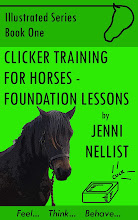Learned helplessness is a debilitated state where the horse has learned that it has no control over the outcomes of its behaviour. It is related to the use of aversive stimulation such as inescapeable restraint coupled with painful or otherwise adverse treatment and is a welfare concern(1). Horses that have no prior experience of successful escape or avoidance in other adverse conditions are more likley to be susceptible(2) .
Scientists called Seligman and Maier (3) took three groups of domestic dogs raised in a lab and tested their ability to escape after receiving one of three treatments. Two groups were put in a harness from which they could not escape - the first group experienced electric shock but learned they could stop it by pushing a panel with their nose. The second group received the shock but could not turn it off. The third group of dogs had no such treatments and were used as controls. When tested on their ability to escape electric shock by jumping a hurdle, the dogs in the first and third groups succeeded but the second group who were subjected to inescapable shock did not succeed. The conclusion was that the dogs that failed to escape had become learned helpless (3).
A possible way of causing learned helplessness in horses is to use the somewhat controversial Imprint Training. This comprises restraining a foal on the ground and exposing it to a variety of aversive stimuli, such as human fingers inserted up the nostrils and other orifices until it no longer struggles against the restraint. It was developed to make foals more tractable to veterinary treatment and husbandry (4).
Newborns have had limited time in which to solve any problems at all, and the procedure involves exposure to adverse stimuli until they stop trying to escape. There is some possible evidence of a learned helpless effect. Compared to controls, imprint trained foals were more easily handled (5,6,7) suggesting that either they had learned they couldn't escape from human handling or had habituated to human intervention. But as the foals got older and had no further imprint training, the differences reduced with imprint trained foals becoming harder to handle (5) with the effects of imprint training disappearing by six-months-of-age (6).
If imprint training did produce learned helplessness effects they clearly did not last. Maier and Seligman (2) also discuss more temporary effects such as mongrel dogs that were not lab reared and only subjects to one session of inescapable shock that were still able to successfully escape over the hurdle when tested.
The take home message. It's not advisable to subject animals to any situation in which they will be frightened and unable to escape!
1. Hall, C. Goodwin, D. Heleski, C. Randle, H. and Waren, N. 2008 Is there evidence of learned helplessness in horses? Journal of Applied Animal Welfare Science 11(3): 246-266
2. Maier, S. and Seligman, M. 1976 Learned helplessness: Theory and evidence Journal of Experimental Psychology: General 105(1): 3-46
3. Seligman, M. and Maier, S. 1967 cited in (2).
4. Miller, R. and Close, P. 1991 Imprint training of the newborn foal. Western horseman, Colorado Springs
5. Williams, J. Friend, T. Collins, M. Toscano, M. Sisto-Burt, A. Nevill, C. 2002 The effects of early training sessions on the reactions of foals at 1, 2 and 3 months of age. Applied Animal Behaviour Science 77: 105-114
6. Williams, J. Friend, T. Collins, M. Toscano, M. Sisto-Burt, A. Nevill, C. 2003 Effects of imprint training procedure at birth on the reactions of foals at age six-months. Equine Veterinary Journal 35(2): 127-132
7. Simpson, B. 2004 Neonatal foal handling. Applied Animal Behaviour Science 78: 303-317
Monday 13 June 2011
Subscribe to:
Posts (Atom)

